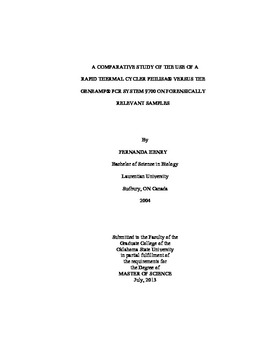| dc.description.abstract | Traditional PCR methods for amplification of multiplex STR systems typically take 3-4 hours, due to the limitations of the Taq DNA polymerase and the thermal cyclers used for amplification. Heat-stable, `fast' polymerases, specially engineered for higher processing times, faster activation rates, and faster extension rates can be used in conjunction with rapid thermal cyclers that are designed to have faster ramp rates than traditional thermal cyclers. Together, these have been demonstrated to dramatically decrease the PCR amplification time of forensically relevant samples, to as little as 17 minutes. However, it is important to determine whether rapid thermal cycling can be reliably implemented into a forensic DNA laboratory, for use on forensic casework.This study compared one such rapid thermal cycling platform, Philisa� (Streck Laboratories Inc., Omaha NE) to the traditional GeneAmp� PCR System 9700 (Applied Biosystems Inc., Foster City, CA) to determine whether the fast PCR method was as robust, sensitive, and reliable as the traditional Taq-based system. Three multiplex PCR amplification kits, namely AmpF?STR� Identifiler�, Yfiler�, and MiniFiler� were evaluated for use on Philisa� and the quality of the genotyping results obtained from the samples amplified with this instrument were reviewed in the context of an internal validation study performed in tandem with studies carried out with the GeneAmp�PCR System 9700. A novel end-point PCR DNA quantification method, Q-TAT�, was also evaluated using the rapid thermal cycler, comparing its performance to that of the traditional GeneAmp� 9700 thermal cycler. Further, a cost analysis of each system demonstrated the financial investment involved with each thermal cycler.The results indicate that while there was a dramatic decrease in PCR amplification time with the rapid thermal cycler, there was a significant increase in PCR artifacts such as stutter. Differences in inter-loci peak imbalance and non-adenylated peaks were also noted. Moreover, the amount of input template DNA required for the fast PCR system was considerably higher than that of the traditional thermal cycler. The two systems performed comparably in terms of heterozygote peak height imbalances and drop-in artifacts.Ultimately, each thermal cycler performed equally well in each study conducted. The Philisa� thermal cycler was faster, but was out-performed by the GeneAmp� PCR System 9700 with the Yfiler� amplification kit and the Q-TAT� method. | |
